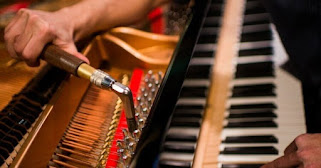Every week, I speak with at least a couple of people who are interested in not giving up on their older piano, but rather bringing it back to a playable condition. There are two ways to do this: Rebuilding and Restoration. Both attempt to restore the piano to its former glory, but the philosophy behind them differs.
.png)
Rebuilding can involve anything from an action overhaul to replacement of soundboard, strings, and pin block. Where possible, new parts are used. I say where possible because while the industry became standardized around the 1920s, pianos prior to that often have parts for which it is impossible to find replacements.
For example, we are doing a rebuild right now for a client in Albany, a piano from 1909. The hammer butts and hammer assemblies are able to be replaced, but the whippens (the mechanism which transfers the energy from the key to the hammer assembly) are non-standard and must be reconditioned by cleaning and by replacing leather and felt where possible.
Rebuilding often gives the best musical results, as newer parts are often superior. However, some people want their piano as true to the original as possible. That is where restoration comes in.
Restoration seeks to use the original parts and historically accurate materials. This will reproduce, as closely as possible, the aesthetic of the time in which the piano was built. This route is most often reserved for pianos which have great historical or sentimental value. It is often cheaper to replace parts than it is to recondition them, as reconditioning is extremely labor-intensive. Thus, the cost of historical restoration of a piano can exceed that of rebuilding by a fair amount.
Whether you are interested in rebuilding or restoring your piano, New York Piano Works is the primer facility for Upstate New York and the entire Hudson Valley. Make an appointment to have your piano evaluated today! www.newyorkpianoworks.com
Get More Info : Piano Restoration Kingston
Contact Us : Harpsichord Repair Hudson Valley


.png)